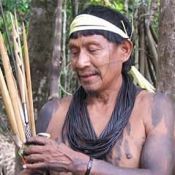Amazonian People Prove They Saved Endangered Rainforest, Become First To Generate REDD Credits
Indigenous people have long been among the most responsible stewards of the rainforest – a role that benefits the world at large but offers little in the way of economic reward for the people themselves. Brazil’s Paiter Suruí have taken a giant step towards changing that by becoming the first indigenous people to prove their actions save the forest.

Indigenous people have long been among the most responsible stewards of the rainforest – a role that benefits the world at large but offers little in the way of economic reward for the people themselves. Brazil’s Paiter Suruí have taken a giant step towards changing that by becoming the first indigenous people to prove their actions save the forest and earning the right to generate credits for the carbon they capture in trees.
2 June 2013 | WASHINGTON, DC | Four years ago, the indigenous Paiter Suruí of the Brazilian Amazon voted to shift the basis of their economic livelihoods away from logging and other activities that require bulldozing the forest and towards activities that conserve it. To finance the shift, they sought to earn credit for the carbon captured in trees under a mechanism known as REDD+ (Reduced Emissions from Deforestation and Degradation, plus sustainable forest management).
Last week, an independent audit confirmed they had become the first indigenous people in the world to generate REDD+ credits under the rigorous criteria of the Verified Carbon Standard (VCS), which requires detailed validation and verification procedures. Their success can now be replicated by other indigenous people, who have long been among the most effective stewards of the land and play a key role on the front lines of combatting climate change.
“REDD+ is a mechanism that unites our values and those of the non-indigenous capitalist world,” says Chief Almir Suruí, who conceived the project in 2007. “This is our contribution to forest preservation, but projects like this can only be achieved by people with a medium- to long-term perspective.”
The project began when Chief Almir approached environmental nonprofit organization Forest Trends to see if carbon finance could be used to preserve the forest. Forest Trends then commissioned the law firm of Baker & McKenzie to see if the Suruí actually owned the rights to carbon in their trees. With that confirmation in hand, they brought in Idesam (Instituto de Conservaçí£o e Desenvolvimento Sustentavel do Amazonas/Institute for the Conservation and Sustainable Development of Amazonas) to determine which portions of the 248,147-hectare territory were in danger and estimate the carbon content. Idesam conservatively estimated that well over five million tons of carbon dioxide would be emitted if the Suruí didn’t act fast.
Over the next two years, Chief Almir worked with longstanding Suruí partners Kanindé (Associaçí£o de Defesa Etnoambiental Kanindé) and ECAM (Equipe de Conservaçí£o da Amazí´nia/Amazon Conservation Team Brazil) to help members of the Suruí understand the project in accordance with the principles of Free, Prior, and Informed Consent (FPIC) as articulated in Convention 169 of the International Labor Organization (ILO). In 2009, the four clans and 25 villages of the Suruí voted to impose and enforce a logging moratorium and to work with Idesam to ensure that the impacts of the Suruí actions were measurable, reportable, and verifiable. In 2010, Funbio (Fundo Brasileiro da Biodiversidade/Brazilian Biodiversity Fund) joined the partnership to create the Suruí Trust Fund and ensure that income from the project is managed responsibly and transparently. Local authorities, including Funai (Fundaçí£o Nacional do índio/National Indian Foundation), have since endorsed the Suruí effort as a model project.
After extensive multidisciplinary review by independent experts, the VCS board and the Climate, Community, and Biodiversity Alliance agreed in 2012 that the steps the Suruí were taking would sequester at least five million tons of carbon dioxide over 30 years while protecting critical rainforest habitat. Verification, however, required further auditing by Imaflora (Instituto de Manejo e Certificaçí£o Florestal e Agrícola/Institute for the Management and Certification of Forests and Farms) and Rainforest Alliance to ensure that those steps were, in fact, being taken. During this time, the Suruí carried out patrols and worked with community members and government authorities to protect their forests.
“It’s been a long and arduous journey,” says Forest Trends President and CEO Michael Jenkins. “But by going first, the Suruí have created a template for other indigenous people across the Amazon.”
Forest Trends is an international, Washington, DC-based non-profit organization whose mission is to maintain, restore, and enhance forests and connected natural ecosystems, which provide life-sustaining processes, by promoting incentives stemming from a broad range of ecosystem services and products.
Additional resources
Please see our Reprint Guidelines for details on republishing our articles.

